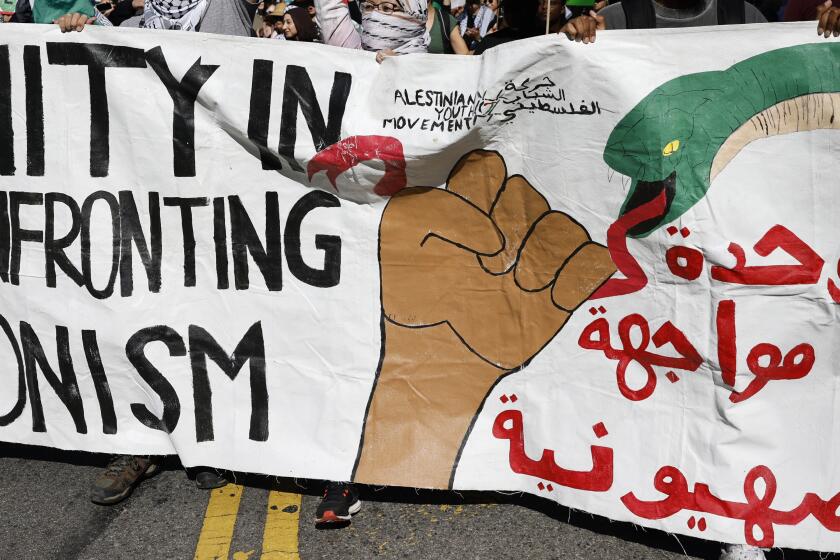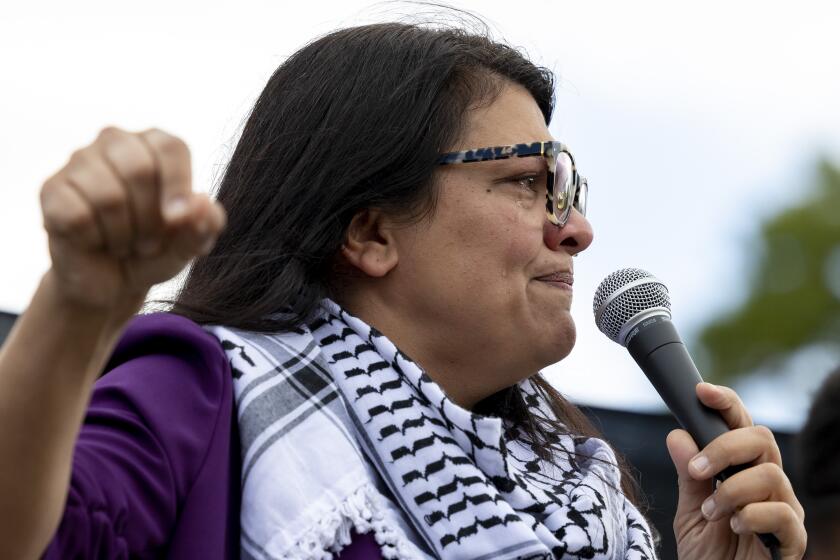Bombings in Gaza add to generations of Palestinians displaced from their homes

- Share via
An estimated 1.4 million Palestinians have been displaced from their homes since the Israeli military began bombing the Gaza Strip on Oct. 8, in retaliation for a surprise attack by Hamas militants. On Tuesday an Israeli strike hit the densely populated Jabaliya refugee camp in North Gaza, leaving many casualties.
Many Palestinian refugees have sought refuge in United Nations emergency shelters in a situation the World Health Organization has described as “catastrophic.” Lacking adequate access to water, food, electricity and other critical supplies, humanitarian agencies are deeply concerned and fear a total breakdown in order.
This is not the first time Palestinians have endured forced migration. Long before the latest upheaval, Palestinians who today live in Gaza and throughout the Middle East were forced from or fled their homes in what became the state of Israel. Today, they number about 5.9 million refugees, almost half of the entire global Palestinian population.
My beloved Gaza of crowded markets and vibrant cafes is gone, demolished and a place of grief
My sisters are taking refuge north of Gaza City in a hospital and a school operated by the United Nations, but no place in Gaza is safe.
The majority of Palestinian refugees today receive aid from the United Nations Relief and Works Agency. Dispersed throughout the region, including in Jordan, Syria, Lebanon and the occupied Palestinian territories, about one-third of all Palestinian refugees live in UNRWA refugee camps, while the remainder live in surrounding cities and towns.
Palestinian displacement cannot be reduced to a single cause. Most Palestinian refugees, however, can trace their roots to two significant events in Palestinian history: the “Nakba” and the “Naksa.”
The principal event in modern Palestinian history and memory is the Nakba, roughly translated into “the catastrophe.” The term refers to the mass displacement of approximately 700,000 Palestinians during the Arab-Israeli War of 1948 and the creation of the state of Israel. The majority of Palestine’s Arab population fled their homes during the war, seeking temporary refuge across the Middle East but hoping to return after hostilities ceased.
The mass exodus of Palestinians in 1948 resulted in two consequential realities. The first involved about 25,000 Palestinians displaced within the boundaries of what became Israel. Known as internally displaced Palestinians, this community did not cross any official border and thus never received refugee status under international law. Instead, they became Israeli citizens, distinguished by their legal designation as “present absentees.” Through the Absentee Property Law, the Israeli state confiscated displaced Palestinians’ properties and denied their right to return to the homes and villages of their birth.
College officials may fear being perceived as taking sides in the Israel-Hamas conflict, but it is wrong to confuse condemning antisemitism with ignoring the plight of the Palestinians.
The second event involved the Palestinians who fled beyond what became the borders of Israel and acquired formal refugee status under the United Nations. This group of refugees sought shelter in areas of Palestine where Israeli forces did not occupy, like Nablus and Jenin, and in neighboring states, including Jordan, Syria, Lebanon and Egypt.
In 1967, the second-largest displacement of Palestinians occurred during the Israeli-Arab War known to Palestinians as Al Naksa, or the “setback.” Fought between Israel, on one side, and Syria, Egypt and Jordan, on the other, the war ended with Israel occupying territory in all three countries, including the remaining areas of Palestine: the West Bank and Gaza Strip. During the war, approximately 400,000 Palestinians were displaced from the West Bank and Gaza primarily to Jordan and housed in one of six new UNRWA refugee camps.
Others found refuge in Egypt and Syria. More than a third of those Palestinians displaced in 1967 were already refugees from 1948 and thus suffered a second forced migration. Just as in 1948, when the 1967 war ended, the Israeli government blocked the return of refugees. It proceeded to destroy several Palestinian villages in the occupied territory, including Emmaus, Yula and Beit Yuba, and lease some of these areas to Jewish Israelis.
Although these two historic events turned many Palestinians into refugees, numerous events since 1967 have increased their number, including Israel’s practice of home demolitions. Whether as a punitive measure or the result of a permit system that rights groups say systematically discriminates against Palestinians, between 2009 and 2023 alone, the practice has left thousands of Palestinians homeless.
Republicans are furious that Michigan Democrat Rashida Tlaib has called for a cease-fire and hasn’t walked in lockstep with establishment views.
Further displacement has resulted from regional wars involving neither Palestinians nor Israelis. Following the end of Iraq’s occupation of Kuwait in 1990, more than 300,000 Palestinians were expelled from Kuwait in retaliation for support offered by the leading Palestinian national organization, the Palestine Liberation Organization, to Saddam Hussein. Since the start of the Syrian Civil War in 2011, more than 120,000 Palestinian refugees have fled the country, primarily to Turkey and Jordan, while another 200,000 have been internally displaced.
No single experience characterizes these groups’ exile. Since 1948, for example, Palestinians in Lebanon have faced severe restrictions in work, education and health. Palestinian refugees in the Hamas-ruled Gaza Strip are under a 16-year blockade established by Israel but supported by the Egyptian government. Since the closure began in 2007, restrictions on the import of goods, the movement of people and access to electricity and other basic resources have produced dire conditions for these Palestinians, including more than 45% unemployment and food insecurity among 70% of households.
Palestinian refugees represent the longest protracted refugee situation in modern history. For 75 years now, they have been forced to live as a stateless population without the ability to return to their homeland.
The duration of their predicament is undoubtedly tied to the uniqueness of their displacement. Palestinians fled a homeland that became the state of Israel, whose leaders treat the return of Palestinians as a demographic threat.
Any solution to Palestinian displacement that involves return to territory in contemporary Israel thus faces the problem of overcoming the current ideas of Israel as a Jewish state. And yet that is the challenge. Whatever peace negotiations may bring, no permanent solution to the Palestine-Israel conflict can avoid answering the question of return.
Michael Vicente Pérez is an associate professor in anthropology at the University of Memphis. This article was produced in partnership with the Conversation.
More to Read
A cure for the common opinion
Get thought-provoking perspectives with our weekly newsletter.
You may occasionally receive promotional content from the Los Angeles Times.












